Abstract
Building construction and building operations have a massive direct and indirect effect on the environment. Cement-based materials will remain essential to supply the growth of our built environment. Without preventive measures, this necessary demand in cement production will imply a substantial increase in CO2 generation. Reductions in global CO2 emissions due to cement consumption may be achieved by improvements on two main areas: increased use of low CO2 supplementary cementitious materials and a more efficient use of Portland cement clinker in mortars and concretes. The use of ground granulated blast furnace slag in concrete, as cement constituent or as latent hydraulic binder, is a current practice, but information of concrete with ladle furnace slag is more limited. Specific knowledge of the behavior of mixtures with steel slag in relation to certain properties needs to be improved. This paper presents the results of the shrinkage (total and autogenous) of five concrete mixtures, produced with different percentages of two different slags in substitution of cement. The results show that shrinkage of concrete with the two different slags diverges. These different characteristics of the two materials suggest that their use in combination can be useful in optimizing the performance of concrete.
1. Introduction
The building and construction sector is a key player that contributes to meeting the needs of housing, hospitals, schools, among others developments, but it is also a large consumer of materials and natural resources. Building construction and building operations have a massive direct and indirect effect on the environment [1,2,3,4,5,6]. Not considering water, concrete may be considered the most used construction material in the world. The most important constituent of concrete is cement. It is produced in a dynamic process including high temperature treatment and a release of approximately 710 kg CO2 per cement ton cement [7].
Cement-based materials will remain essential to supply the growth of our built environment, mainly by those located in the developing world. Without preventive measures, this needed demand in cement production will imply a substantial increase in CO2 generation, further aggravating the environmental aspects and global warming. According to United Nations [8] there are two main areas that can deliver very considerable additional reductions in global CO2 emissions related to cement and concrete production and use (not including carbon capture and storage (CCS)):
- Increased use of low-CO2 supplements (supplementary cementitious materials) as partial replacements for Portland cement clinker.
- More efficient use of Portland cement clinker in mortars and concretes.
In fact, the use of industrial and construction waste as raw materials for the production of cement and concrete can be considered not only to reduce CO2 emissions and the amount of embodied energy, but also to contribute to a circular economy and to diminish the environmental threats associated with industrial waste materials. This partial substitution of Portland cement clinker by appropriate composite materials need to feature a certain chemical activity in order to assure cement quality [9]. Moreover, the main problem associated to the iron and steel industry is waste generation and by-products. To promote environmental sustainability and circular economy it is essential to promote the reuse of these by-products. One of these by-products is steel slag. The use of slag in the concrete has been going on for some time all over the world, especially in cement as an addition to the mix of cement manufactured in plant, under certain conditions, to make up the cements CEM II, CEM III and cement V [10]. This subject is relatively well studied and documented for main properties, however, for more specific properties such as shrinkage further studies are needed [11,12,13,14,15].
Depending on different factors, mainly due to the manufacturing process, four types of steel slag can be identified: blast furnace slag (BFS), ladle furnace slag (LFS), electric arc furnace (EAF) and basic oxygen furnace slag (BOFS) [16]. On the other hand, one of the essential aspects in promoting the most efficient use of cement materials in the production of concrete is the maximization of its durability. For good long-term behavior, it is essential to reduce the cracking of reinforced concrete elements. In this sense shrinkage evaluation and shrinkage crack reduction is an important factor. The assessment of time-dependent behavior is still one of the most difficult features in designing a concrete structure [17]. The structural concrete codes dealing with time dependent behavior provide common rules for regular concrete and the confirmation of some established stress-strain-relations have to be confirmed through laboratory tests when special mixtures are used [18,19,20].
Shrinkage is the diminution in either length or volume of a material, after suffering changes in chemical properties or moisture content, and occurs in the absence of external actions applied to the concrete [21]. If moisture transfer with the adjacent environment is not permitted, and temperature is kept constant, this volume variation is called autogenous shrinkage and is attributed to self-desiccation due to binder hydration [22].
Standardization in the field of construction products, and in particular in the field of concrete with hydraulic binders, has been providing an increase in the quality and durability requirements of concrete structures. Indeed, in order to achieve sustainable development in construction, while continuing to use concrete, it is necessary, among other aspects, to maximize the durability of the structures. According to Mehta [23], this solution represents a major step in the optimization of resources in the construction industry. In addition, it is necessary to ensure that the capacities of the materials and elements of the structures that are designed and built are fully exploited and maximized in service, in the respective useful life period [24]. The reduction of shrinkage cracking is very important from the point of view of durability, as well as resistance and behavior in service.
This paper presents the results of the shrinkage (total and autogenous) of five concrete mixtures, produced with different percentages of two different slags in substitution of cement. This information can be useful for minimizing the cracking of concrete elements, due to shrinkage, and improving its performance in service, contributing to the greater use of slag and to a more sustainable construction.
2. Materials and Methods
In this work, five concrete mixtures were prepared, namely, a reference mixture without cement replacement and four mixtures in which 25% and 40% cement replacement (mass), using separately ground granulated blast furnace slag (GGBFS) or ladle furnace slag (LFS). Portland cement, class strength 52.5 R, was used because this cement contains 95–100% Portland cement clinker. Since this research is part of a larger project that is studying the use of landfill slag as a concrete constituent, for the production of precast concrete, the concrete dosage has been designed in order to meet a dry consistency.
The percentages of cement replacement by slag were defined based on the results obtained by Rubio [25].
The mixtures were prepared using the following materials:
- Cement: Portland Cement CEM I 52.5 R.
- Slag 1: Ground granulated blast furnace slag (GGBFS), particle size <0.063 µm provided by the company (ESTABISOL S.A.).
- Slag 2: Unprocessed ladle furnace slag (LFS). This slag was sieved in laboratory in order to increase the particle size <0.063 µm fraction (23%).
- Aggregates: crushed limestone. Fine sand (0/2), medium size sand (0/4) and gravel (4/12).
- Chemical admixture: Superplasticizer.
- Water: Tap water.
Physical and chemical characteristics of the cement and slag used are presented in Table 1.

Table 1.
Cement and slag chemical composition, density and specific surface area. (Data provided by the suppliers).
The grading curves of the used aggregates are presented in Figure 1.
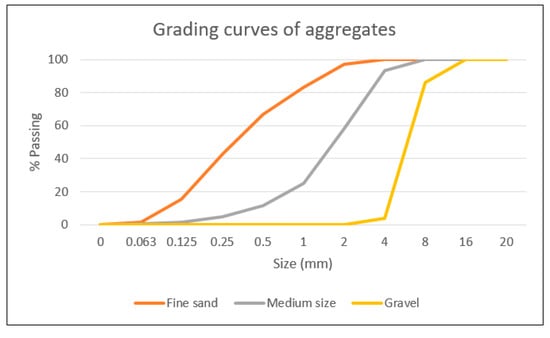
Figure 1.
Grading curves of used aggregates.
Table 2 presents the concrete mixture proportions. They were named as follow:

Table 2.
Concrete mixture proportions.
- Mixture 1 (REF): Ordinary concrete without slag;
- Mixture 2 (25GGBFS): Concrete with 25% cement replaced with GGBFS;
- Mixture 3 (40GGBFS): Concrete with 40% cement replaced with GGBFS;
- Mixture 4 (25LFS): Concrete with 25% cement replaced with LFS;
- Mixture 5 (40LFS): Concrete with 40% cement replaced with LFS
The preparation of the prismatic specimens (160 mm × 40 mm × 40 mm) was performed according to EN 196-1 [26], in a room with a temperature of 20 ± 2 Celsius degrees and a relative humidity of 55% ± 5. It was decided to use small specimens since the ratio between smallest size of the specimen and largest aggregate size is about 3. Nevertheless, the mixture proportions and the aggregates used in this research are different from those indicated in [26].
Aitcin [27] recommends that the shrinkage measurement should be started as soon as possible; otherwise the measurement performed may underestimate the real shrinkage. In this sense the compressive strength of the mixtures in the first hours was monitored, through the procedure described in the EN 196-1, although adapted to concrete. The results are presented on Table 3.

Table 3.
Concrete mixtures: early age compressive strength.
The removal of molds took place about 4 h after mixing. This time delay was defined as the minimum required time to ensure concrete strength between 2 MPa and 4 MPa, in order to avoid specimens damage. At 28 days the compression strength of the REF mixture was 50 MPa [13]. The tests performed on the prismatic specimens were: drying shrinkage, autogenous shrinkage and expansion under water immersion. The samples used for the autogenous shrinkage test were sealed with a plastic film (Figure 2). Samples for autogenous and drying shrinkage tests were placed on two thin supports and the others samples were immersed in water to achieve saturated conditions (Figure 3). Linear deformations of each specimen were measured using a length comparator with the sensitivity of 1 µm (Figure 4). Gage studs were located at the end sections of the concrete prisms (Figure 5). At the ages of 1, 3, 7, 14 and 28 days, and 2, 3, 4, 5, 6, 7, 8 and 9 months, the specimens were weighed and the length variation was measured, using the procedures described in Draft prEN 12390-16 [28]. For shrinkage, the measuring positions were along the principal axis of the specimen.
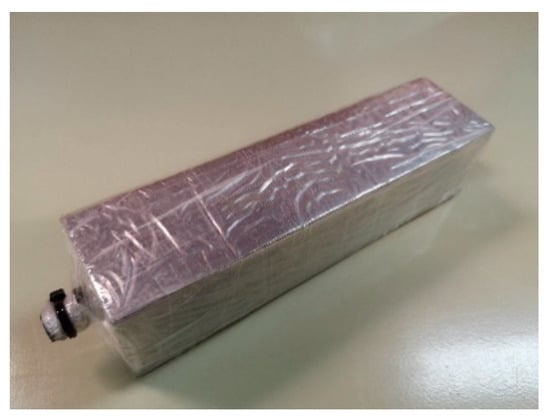
Figure 2.
Sample for measurement of autogenous shrinkage.
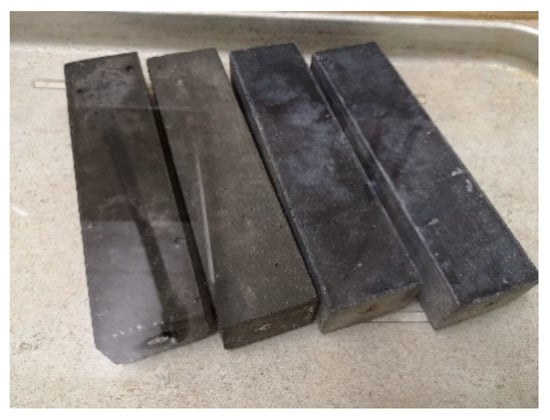
Figure 3.
Samples immersed in water.
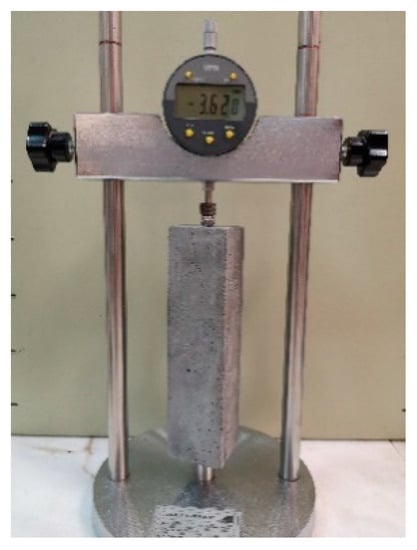
Figure 4.
Length comparator.
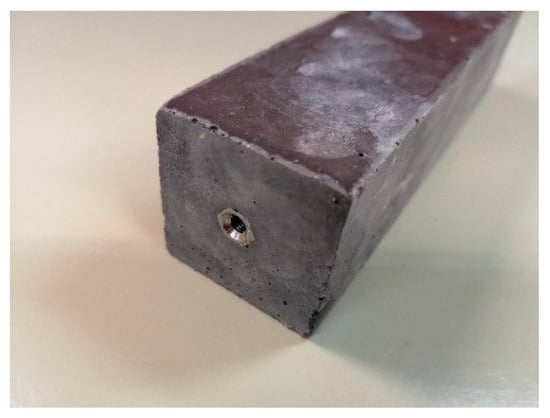
Figure 5.
Gage studs at the end sections of the specimens.
3. Results
The test results obtained on the five series of specimens allowed comparing their relative performance regarding mass change and shrinkage. Section 3.1 and Section 3.2 are dedicated to the presentation of the results of mass change and shrinkage, respectively, using figures but without discussion. The analysis of the results is presented in Section 4.
3.1. Mass Change
The charts in the following figures (Figure 6, Figure 7, Figure 8, Figure 9 and Figure 10) show the mass variation for the mixtures: REF; 25GGBFS, 40GGBFS, 25LFS, 40LFS, recorded up to 9 months (each value presented is the average of three specimens). The individual results deviation were very small (SD < 0.14%).
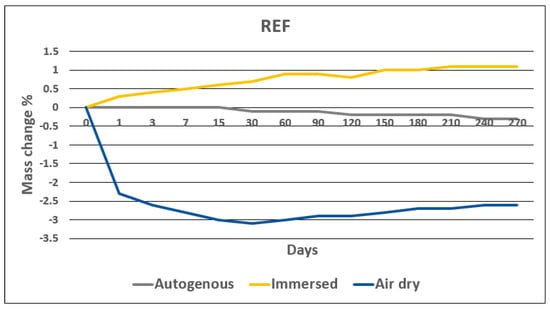
Figure 6.
Mass change of mixture REF.
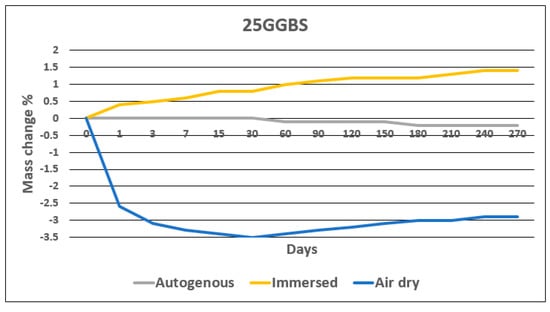
Figure 7.
Mass change of mixture 25GGBS.
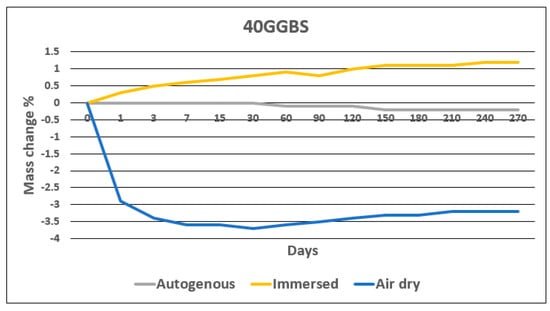
Figure 8.
Mass change of mixture 40GGBS.
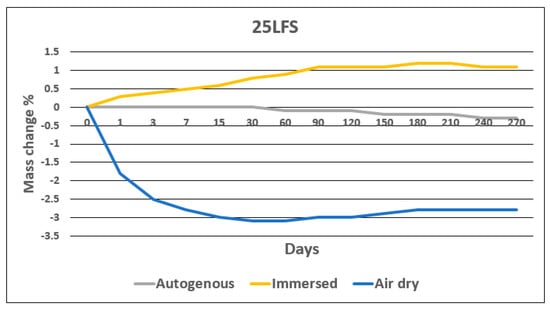
Figure 9.
Mass change of mixture 25LFS.
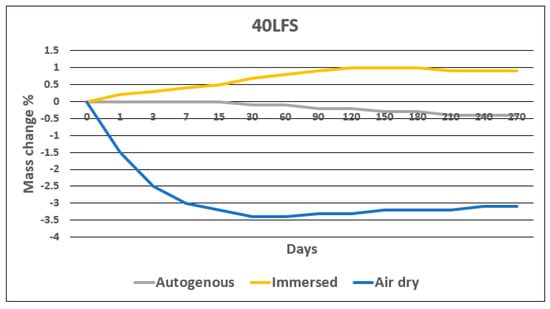
Figure 10.
Mass change of mixture 40LFS.
3.2. Shrinkage
The following results, presented in the form of graphs (Figure 11, Figure 12, Figure 13, Figure 14 and Figure 15), were obtained using the shrinkage measurements of nine specimens per mixture (three for each condition: air dry, sealed and immersed). For each mixture, the solid curves present the average and the dashed curves present the average plus or minus one standard deviation (SD), recorded up to 9 months of age.
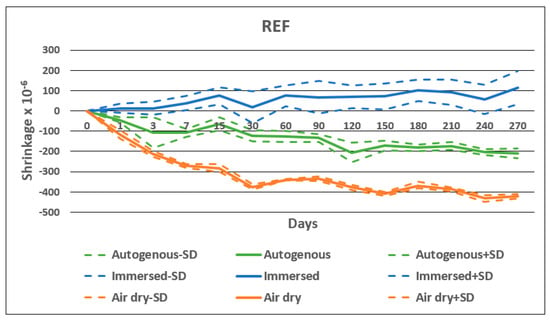
Figure 11.
Strain of mixture REF.
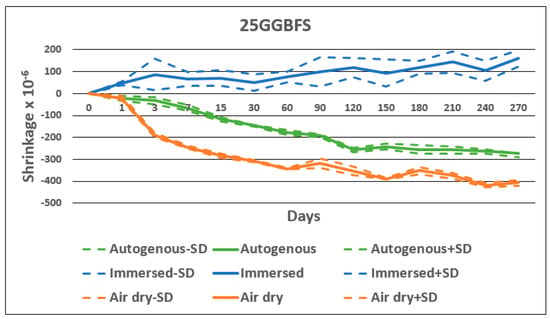
Figure 12.
Strain of mixture 25GGBS.
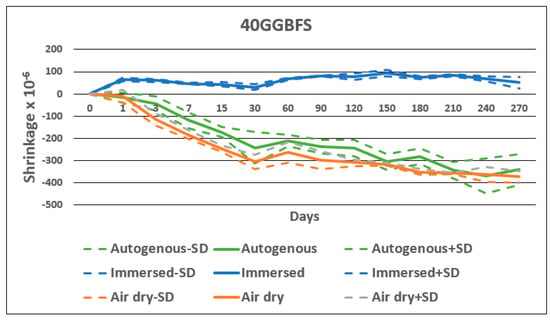
Figure 13.
Strain of mixture 40GGBS.
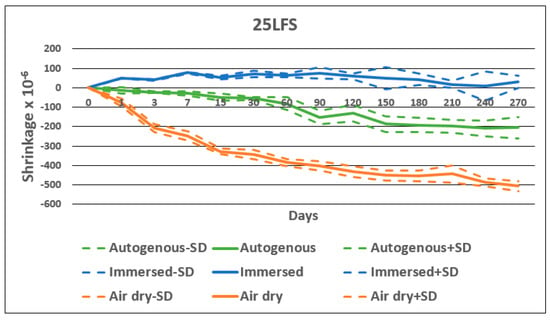
Figure 14.
Strain of mixture 25LFS.
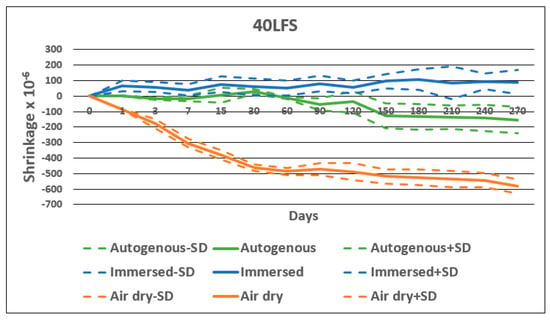
Figure 15.
Strain of mixture 40LFS.
4. Discussions
Regarding mass variation of sealed specimens, in the first month there was almost no mass change. After 30 days, there was a very small loss of mass, but it did not reach even 0.5% at 270 days. The immersed specimens presented mass gain, as expected.
The mass loss in the first 30 days of specimens exposed to air drying is presented in Figure 16. In first 3 days, this figure shows an increase of the mass loss with increasing GGBFS. The lower early age strength of mixtures with increasing GGBFS contents (Table 3) is a consequence of the slower growth of the structural network, leaving the solid body more exposed to drying. However, despite the lower strength, at 3 days, mixtures with LFS did not show higher mass loss than the reference mixture. As the LFS density is lower than the density of cement or GGBFS, the LFS paste has higher solids content, decreasing the porosity when expressed in volume. Thus, the volume of liquid available for evaporation, in relative terms, is smaller, which may be the cause of the initial low loss of mass. In addition, LFS has higher content of CaO than GGBFS. If some of this CaO is in the form of CaCO3, the fine particles of calcium carbonate accelerate the initial hydration reaction and influence the hydrate assemblage of the hydrating cement pastes [29]. At later ages, the influence of the porous structure becomes dominant, and the mass loss of the LFS specimens progressively becomes higher than the mass loss of the reference specimens.

Figure 16.
Mass loss in the first 30 days of specimens exposed to air drying.
Figure 17 shows the results of the autogenous shrinkage tests. The reference mixture presents a shrinkage of about 100 microstrains at 30 days, which is in agreement with w/c of 0.5, that is, poor conditions to develop desiccation. In fact, autogenous shrinkage depends on internal relative humidity [30], and autogenous shrinkage decreases as w/c increases [31,32]. A paste with w/c = 0.6 may present a swelling behavior in the first month, since the amount of available internal water largely surpasses the strictly required water to full hydration [33]. Additionally, as aggregates act as restrictions to the free paste movements [34], a concrete with w/c = 0.5 is expected to present low autogenous shrinkage values in the first days, in accordance with reference ones. At later ages, the reference shrinkage reaches 200 microstrains, due to further hydration and marginal drying. In the first days, mixtures with GGBFS had lower shrinkage than the reference mixture, due to the delay in the formation of the structural network [35,36], but after 2 weeks the autogenous shrinkage of mixtures with GGBFS is higher than the reference one. This is in agreement with other works [35], indicating that with the increase in the content of GGBFS, the autogenous shrinkage increases. This is not the case of LFS. The results obtained with LFS at later ages suggest absence of more compact microstructure that is expected when using slag [36]. It is well-known that the change of microstructure due to the formation of hydration products usually leads to an increase of the autogenous shrinkage. Indeed, autogenous shrinkage is used as an indirect measure of the degree of hydration [37]. With age, there is a shrinkage increase due to grow of the degree of hydration, which is seen in LFS mixtures. However, the autogenous shrinkage of LFS mixtures is not higher than the autogenous shrinkage of the reference mixture, and the shrinkage values did not increase with increasing the LFS dosage. This indicates that, at later ages, the influence of a large content of LFS in the rate of hydration is small or absent.
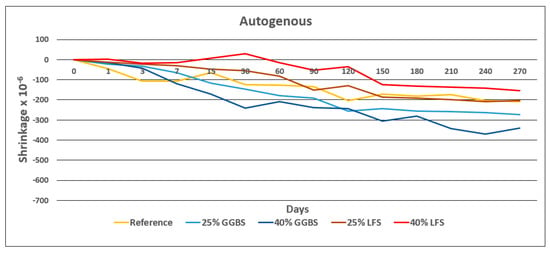
Figure 17.
Autogenous shrinkage—evolution of the five mixtures.
Figure 18 presents the expansion of the five mixtures for immersed conditions. The results do not show evidence of presence of deleterious materials. Expansion of 40–160 microstrain at nine months in those conditions may be considered usual values for normal concrete. Considering the total deformation in autogenous shrinkage tests is actually the sum of the “pure” autogenous shrinkage and the swelling [38], specimens underwater with w/c = 0.5 should present very low “pure” autogenous shrinkage, due to the large source of water, prevailing the swelling component. According to [38] hydration always causes expansion, and consequently, higher swelling may indicate higher hydration. However, considering the expansion is caused by growing diameters of C-S-H shells surrounding the remnants of anhydrous cement grains, the swelling depends on contact pressure which is related with solid part configuration differing from paste to paste. Taking into account the accuracy of the test and the low values of expansion, the results does not allow detecting significant variations due to the presence of slag in the mixtures.
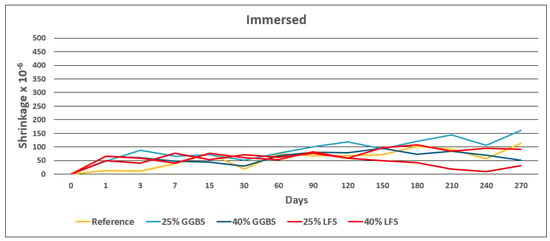
Figure 18.
Shrinkage of the immersed specimens—evolution of the five mixtures.
Figure 19 presents the results of shrinkage in air-drying conditions. Reference and GGBFS specimens present similar air-drying shrinkage, which is in line with the indication of [39] which suggests that drying shrinkage is similar in Portland-cement concrete and concrete containing slag cement. However, the mixtures containing LFS show higher drying shrinkage, with increasing shrinkage as the LFS dosage increases. This also indicates that LFS contribution to a more compact microstructure is smaller than the contribution of GGBFS.
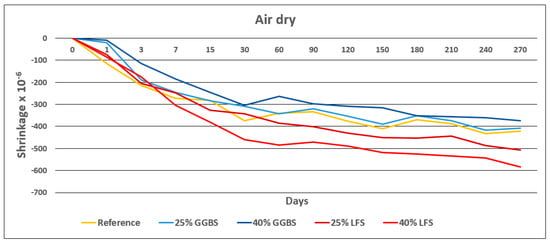
Figure 19.
Shrinkage of the air dry specimens—evolution of the five mixtures.
5. Conclusions
The work presented is dedicated to the evaluation of the influence of steel slag type on concrete shrinkage. For comparison purposes a reference mixture without slag and mixtures with the same content of GGBFS and LFS were also prepared. The results show that shrinkage of concrete with LFS is different from concrete with GGBFS. Concrete with LFS show smaller autogenous shrinkage and higher drying shrinkage than concrete with GGBFS. The swelling underwater of GGBS and LFS mixtures was similar. At very early age, concrete with LFS shows lower mass loss and higher strength than concrete with GGBFS. The tests performed are not enough to support a full rational for this behavior; however, they show that LFS is not improving the hydration at later ages when compared with GGBS. It is speculated that the higher early strength of LFS mixtures may be related with higher CaO content of LFS, when compared to GGBS. As the two materials present different characteristics, their use in combination may be useful in optimizing the performance of concrete, that is, when shrinkage at early age is more relevant, partial replacement of GGBFS by LFS may reduce early age cracking, but the subject deserves further studies.
Author Contributions
Conceptualization, M.J.O., A.B.R., M.E.P.-R., F.P.-G. and M.D.R.-C.; methodology, M.J.O., M.E.P.-R.; software, M.J.O., A.B.R.; validation, M.J.O., A.B.R., M.E.P.-R., F.P.-G., M.D.R.-C.; formal analysis, M.J.O., A.B.R.; investigation, M.J.O., A.B.R., M.E.P.-R., F.P.-G., M.D.R.-C., writing—original draft preparation, M.J.O., A.B.R., M.E.P.-R., F.P.-G., M.D.R.-C. All authors have read and agreed to the published version of the manuscript.
Funding
This research received no external funding.
Institutional Review Board Statement
Not applicable.
Informed Consent Statement
Not applicable.
Data Availability Statement
Not applicable.
Acknowledgments
The authors express thanks to technical teams of: “Laboratorio de Materiales de Construcción” of “Escuela Politécnica Superior de Algeciras”—Cádiz University and “Laboratório de Materiais de Construção (LMC)” from Engineering Institute—Algarve University.
Conflicts of Interest
The authors declare no conflict of interest.
References
- Levin, H. Systematic evaluation and assessment of building environmental performance (SEABEP). In Proceedings of the Second International Conference on Buildings and the Environment, CSTB and CIB, Paris, France, 6–7 June 1997; pp. 9–12. [Google Scholar]
- Hu, M.; Milner, D. Visualizing the research of embodied energy and environmental impact research in the building and construction field: A bibliometric analysis. Dev. Built Environ. 2020, 3, 100010. [Google Scholar] [CrossRef]
- Junnila, S.; Horvath, A. Life-cycle environmental effects of an office building. J. Infrastruct. Syst. 2003, 9, 157–166. [Google Scholar] [CrossRef]
- Zabalza Bribián, I.; Aranda Usón, A.; Scarpellini, S. Life cycle assessment in buildings: State-of-the-art and simplified LCA methodology as a complement for building certification. Buil. Environ. 2009, 12, 2510–2520. [Google Scholar] [CrossRef]
- Green Building Council. Buildings and Climate Change, United Green Building Council. 2020. Available online: https://cdn01.rockwool.com/siteassets/rw-na-ranson/sustainability/usgbc-buildings-and-climate-change-report.pdf?f=20181205094253 (accessed on 20 January 2020).
- United National Environment Programme, 2018, Global Status Report 2018, United National Environment Programme. Available online: https://www.unenvironment.org/resources/report/global-status-report-2018 (accessed on 20 January 2020).
- Verein Deutscher Zementwerke e.V. (VDZ). Monitoring-Abschlussbericht 1990–2012—Verminderung der CO2-Emissionen, Germany, 2013. Available online: https://www.vdz-online.de/wissensportal/publikationen/monitoring-abschluss-bericht-1990-2012-verminderung-der-co2-emissionen (accessed on 26 December 2020).
- United Nations Environment Programme. Eco-Efficient Cements: Potential Economically Viable Solutions for a Low-CO2 Cement Based Materials Industry. Available online: www.unep.org (accessed on 20 October 2020).
- Scrivener, K.L.; John, V.M.; Gartner, E.M. Eco-Efficient Cements: Potential, Economically Viable Solutions for a Low-CO2, Cement-Based Materials Industry; UNEP: Paris, France, 2016. [Google Scholar]
- CEN, EN 197-1. Cement—Part 1: Composition, Specifications and Conformity criteria for Common Cements; CEN, Central Secretariat, Rue de Stassart: Brussels, Belgium, 2000. [Google Scholar]
- Yuksel, I. Blast-Furnace Slag, Waste and Supplementary Cementitious Materials in Concrete, Characterization, Properties and Applications. Woodhead Publishings Series in Civil and Structural Enginnering. 2018, pp. 361–415. Available online: https://www.elsevier.com/books/book-series/woodhead-publishing-series-in-civil-and-structural-engineering (accessed on 26 December 2020).
- Parron-Rubio, M.E.; Perez-Garcia, F.; Gonzalez-Herrera, A.; Oliveira, M.J.; Rubio-Cintas, M.D. Slag Substitution as a Cementing Material in Concrete: Mechanical, Physical and Environmental Properties. Materials 2019, 12, 2845. [Google Scholar] [CrossRef] [PubMed]
- Parron-Rubio, M.E.; Perez-García, F.; Gonzalez-Herrera, A.; Rubio-Cintas, M.D. Concrete Properties Comparison When Substituting a 25% Cement with Slag from Different Provenances. Materials 2018, 11, 1029. [Google Scholar] [CrossRef] [PubMed]
- Perez-Garcia, F.; Parron-Rubio, M.E.; Garcia-Manrique, J.M.; Rubio-Cintas, M.D. Study of the suitability of different types of slag and its influence on the quality of green grouts obtained by partial replacement of cement. Materials 2019, 12, 1166. [Google Scholar] [CrossRef] [PubMed]
- Perez-Garcia, F.; Rubio-Cintas, M.D.; Parron-Rubio, M.E.; Garcia-Manrique, J.M. Advances in the Analysis of Properties Behaviour of Cement-Based Grouts with High Substitution of Cement with Blast Furnace Slags. Materials 2020, 13, 561. [Google Scholar] [CrossRef] [PubMed]
- Setién, J.; Hernández, D.; González, J.J. Characterization of ladle furnace basic slag for use as a construction material. Constr. Build. Mater. 2009, 23, 1788–1794. [Google Scholar] [CrossRef]
- Bisschop, J. Evolution of Solid Behaviour. In Early Age Cracking in Cementitious Systems, RILEM TC 181-EAS. July 2009; 27–34. [Google Scholar]
- Oliveira, M.J.; Ribeiro, A.B.; Branco, F.G. Shrinkage of self-compacting concrete. A comparative analysis. J. Build. Eng. 2017, 9, 117–124. [Google Scholar] [CrossRef]
- CEN. Eurocode 2, Design of Concrete Structures, Part1: General Rules for Building. Europen Standard; European Committee for Standardization: Brussels, Belgium, 1992; pp. 28–31. [Google Scholar]
- ACI 318-11: Building Code Requirements for Structural Concrete and Commentary. Available online: https://www.pecivilexam.com/Study_Documents/Struc-Materials-Online/ACI_318-Building-Code-2011.pdf (accessed on 26 December 2020).
- ACI CT-13, ACI Concrete Terminology, American Concrete Institute. 2013. Available online: https://www.concrete.org/portals/0/files/pdf/aci_concrete_terminology.pdf (accessed on 26 December 2020).
- Tazawa, E. Autogenous Shrinkage of Concrete. In Proceedings of the International Workshop organized by JCI (Japan Concrete Institute), Hiroshima, Japan, 3–8 June 1998; pp. 13–14. [Google Scholar]
- Mehta, K. Reducing the environment impact of concrete—Concrete can be durable and environmentally friendly. Concr. Int. 2001, 23, 61–66. [Google Scholar]
- Swamy, R.N. Sustainable concrete for infrastructure regeneration and reconstruction, in Sustainable Construction into the next Millennium: Environmentally friendly and innovative cement based materials. In Proceedings of the International Conference, João Pessoa, Brazil, 24–26 November 2000; pp. 15–43. [Google Scholar]
- Rubio, M.E.P. Industrialización de Procesos Y Valoración de Residuos Siderúrgicos. Ph.D. Thesis, Universidad de Malaga, Málaga, Spain, December 2018. [Google Scholar]
- CEN. NP EN 196-1:2006—Métodos de ensaio de cimentos. Parte 1: Determinação das resistências mecânicas, Versão portuguesa da norma europeia EN 196-1:2005, IPQ. 2006. Available online: http://repositorio.furg.br/handle/1/1477 (accessed on 26 December 2020).
- Aitcin, P. Autogenous shrinkage measurement. In AUTOSHRINK`98, Proceedings of the International Workshop on Autogenous Shrinkage of Concrete, June 13-14 1998; Tazawa, E., Ed.; Japan Concrete Institute: Hiroshima, Japan, 1998; pp. 245–256. [Google Scholar]
- CEN. DRAFT prEN 12390-16—Testing Hardened Concrete—Part 16: Determination of the Shrinkage of Concrete; European Committee for Standardization: Brussels, Belgium, April 2018. [Google Scholar]
- Lothenbach, B.; Le Saout, G.; Gallucci, E.; Scrivener, K. Influence of limestone on the hydration of Portland cements. Cem. Concr. Res. 2008, 38, 848–860. [Google Scholar] [CrossRef]
- Lura, P.; Jensen, O.M.; Van Breugel, K. Autogenous shrinkage in high-performance cement paste: An evaluation of basic mechanisms. Cem. Concr. Res. 2003, 33, 223–232. [Google Scholar] [CrossRef]
- Zhang, M.H.; Tam, C.T.; Leow, M.P. Effect of water-to-cementitious materials ratio and silica fume on the autogenous shrinkage of concrete. Cem. Concr. Res. 2003, 33, 1687–1694. [Google Scholar] [CrossRef]
- Baroghel-Bouny, V.; Mounanga, P.; Khelidj, A.; Loukili, A.; Rafai, N. Autogenous deformations of cement pastes Part II. W/C effects, micro–macro correlations, and threshold values. Cem. Concr. Res. 2006, 36, 123–136. [Google Scholar] [CrossRef]
- Powers, T.C.; Brownyard, T.L. Studies of the physical properties of hardened portland cement paste. Research Laboratories of the Portland Cement Association, Bulletin 22, Journal of the American Concrete Institute, March, 1948, Chicago, 992p. Available online: https://www.concrete.org/publications/internationalconcreteabstractsportal.aspx?m=details&i=15301 (accessed on 26 December 2020).
- Holt, E. Contribution of mixture design to chemical and autogenous shrinkage of concrete at early ages. Cem. Concr. Res. 2005, 35, 464–472. [Google Scholar] [CrossRef]
- Matthes, W.; Vollpracht, A.; Villagrán, Y.; Kamali-Bernard, S.; Hooton, D.; Gruyaert, E. Ground granulated blast-furnace slag. In Properties of Fresh and Hardened Concrete Containing Supplementary Cementitious Materials. RILEM State-of-the-Art Reports; De Belie, N., Soutsos, M., Gruyaert, E., Eds.; Springer: Cham, Switzerland, 2018; Volume 25. [Google Scholar] [CrossRef]
- Giergiczny, Z. Fly ash and slag. Cem. Concr. Res. 2019, 124, 105826. [Google Scholar] [CrossRef]
- Morina, V.; Cohen-Tenoudjia, F.; Feylessoufib, A.; Richard, P. Evolution of the capillary network in a reactive powder concrete during hydration process. Cem. Concr. Res. 2002, 32, 1907–1914. [Google Scholar] [CrossRef]
- Rasoolinejad, M.; Rahimi-Aghdam, S.; Bažant, Z.P. Prediction of autogenous shrinkage in concrete from material composition or strength calibrated by a large database, as update to model B4. Mater. Struct. Constr. 2019, 52, 33. [Google Scholar] [CrossRef]
- ACI-233R-03 (ACI 233R-03 (2011)). Slag Cement in Concrete and Mortar; American Concrete Institute: Farmington Hills, MI, USA, 2011; Available online: https://www.concrete.org/publications/internationalconcreteabstractsportal/m/details/id/12648 (accessed on 26 December 2020).
Publisher’s Note: MDPI stays neutral with regard to jurisdictional claims in published maps and institutional affiliations. |
© 2020 by the authors. Licensee MDPI, Basel, Switzerland. This article is an open access article distributed under the terms and conditions of the Creative Commons Attribution (CC BY) license (http://creativecommons.org/licenses/by/4.0/).